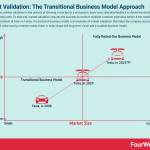What Is Market Validation? Market Validation In A Nutshell


In simple terms, market validation is the process of showing a concept to a prospective buyer and collecting feedback to determine whether it is worth persisting with. To that end, market validation requires the business to conduct multiple customer interviews before it has made a significant investment of time or money. A transitional business model is an example of market validation that helps the company secure the needed capital while having a market reality check. It helps shape the long-term vision and a scalable business model.
Understanding market validationMarket validation, therefore, is used to determine whether there is a need for a product or service in a business’s target market.
Market validation can be used in several different contexts. Some entrepreneurs use it when they are founding a new startup based around an innovative product idea. More established businesses may also use market validation when considering whether to launch a new product or add new features to an existing product.
Market validation is important for two main reasons:
Failure avoidance – the sunk costs associated with a product that fails when presented to the market are significant. Market validation is a way to validate an idea for viability before committing substantial resources.Funding procurement – when an idea is deemed to be viable, this validation is used to convince key stakeholders to commit to funding the rest of the project. This is particularly crucial for early-stage startups where time is of the essence and funding tends to be more difficult to obtain.How to perform market validationThere is no set market validation framework, with many of the framework components dependent on the nature of the industry, project, and the way project managers like to work.
Nevertheless, we have provided a basic outline of the process below.
Start with an assumptionTo validate an assumption about the market, the business must first define a list of assumptions that it wants to test. These may be related to market demand, the ability of a product to solve consumer problems, or whether the product price will be suitable.
Define the testThe most prevalent market validation methods are those we mentioned earlier: customer interviews and surveys. However, some businesses will build an MVP while others will conduct prototype, usability, or SEO-based tests.
It is important to construct the tests with questions that provide clarification on the assumptions made in step one. Consider, for example, the following survey questions:
Does this feature help solve your problem? How would you explain what this product does? How often do you estimate you’d use the new feature? What tools or products, if any, were you using to solve the problem previously?Recruit participantsWhile an obvious point to make, the business must recruit participants that represent the actual end-user or buyer. People tend to be averse to studies as a general rule, so it may be wise to provide various incentives to ensure the data set collected is sufficiently large.
For instance, the business may opt to cover travel costs of each participant or provide them with a voucher to use in-store.
Conduct the experiment and reviewOnce everything is in place, run the experiment and evaluate the results. Remember that proving an assumption wrong is not the same as failing; it is simply a matter of repeating the process until the assumptions are correct.
If nothing else, this keeps the product team humble and serves as a reminder to never assume they know exactly what the consumer wants before asking them.
Transitional Business Models A transitional business model is used by companies to enter a market (usually a niche) to gain initial traction and prove the idea is sound. The transitional business model helps the company secure the needed capital while having a reality check. It helps shape the long-term vision and a scalable business model.Key takeaways:Market validation is used to determine whether there is a need for a product or service in a business’s target market.Market validation is important for two main reasons: failure avoidance and funding procurement. Each reason is related to the other and enables product development teams to move forward with viable ideas that do not prove to be fruitless.Market validation can be performed in four basic steps: start with the assumption, define the test, recruit participants, and conduct the experiment and review.
A transitional business model is used by companies to enter a market (usually a niche) to gain initial traction and prove the idea is sound. The transitional business model helps the company secure the needed capital while having a reality check. It helps shape the long-term vision and a scalable business model.Key takeaways:Market validation is used to determine whether there is a need for a product or service in a business’s target market.Market validation is important for two main reasons: failure avoidance and funding procurement. Each reason is related to the other and enables product development teams to move forward with viable ideas that do not prove to be fruitless.Market validation can be performed in four basic steps: start with the assumption, define the test, recruit participants, and conduct the experiment and review.Main Free Guides:
Business ModelsBusiness CompetitionBusiness StrategyBusiness DevelopmentDigital Business ModelsDistribution ChannelsMarketing StrategyPlatform Business ModelsRevenue ModelsTech Business ModelsBlockchain Business Models FrameworkThe post What Is Market Validation? Market Validation In A Nutshell appeared first on FourWeekMBA.



